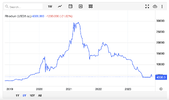Knobby22
Mmmmmm 2nd breakfast
- Joined
- 13 October 2004
- Posts
- 9,617
- Reactions
- 6,411
If I wanted to hoard a metal this would be it.
Useful, rare and has been going up. Even can be used in jewellery. It's sort of a better type of platinum.
https://moneyweek.com/504029/chart-of-the-week-rhodium-on-the-rise
A hard, shiny, silvery metal.
Uses
Rhodium has no known biological role. It is a suspected carcinogen.
Natural abundance
Rhodium is the rarest of all non-radioactive metals. It occurs uncombined in nature, along with other platinum metals, in river sands in North and South America. It is also found in the copper-nickel sulfide ores of Ontario, Canada.
Rhodium is obtained commercially as a by-product of copper and nickel refining. World production is about 30 tonnes per year.
Useful, rare and has been going up. Even can be used in jewellery. It's sort of a better type of platinum.
https://moneyweek.com/504029/chart-of-the-week-rhodium-on-the-rise
A hard, shiny, silvery metal.
Uses
- alloying agent to harden platinum and palladium. Such alloys are used for furnace windings, thermocouple elements, bushings for glass fibre production, electrodes for aircraft spark plugs, and laboratory crucibles
- used as an electrical contact material as it has a low electrical resistance, a low and stable contact resistance, and is highly resistant to corrosion
- plated rhodium produced by electroplating or evaporation is exceptionally hard and is used for optical instruments
- used for jewellery
- industrial catalyst
- rhodium is used as part of the catalytic system in car catalytic converters, used to clean up exhaust gases to some extent
Rhodium has no known biological role. It is a suspected carcinogen.
Natural abundance
Rhodium is the rarest of all non-radioactive metals. It occurs uncombined in nature, along with other platinum metals, in river sands in North and South America. It is also found in the copper-nickel sulfide ores of Ontario, Canada.
Rhodium is obtained commercially as a by-product of copper and nickel refining. World production is about 30 tonnes per year.

